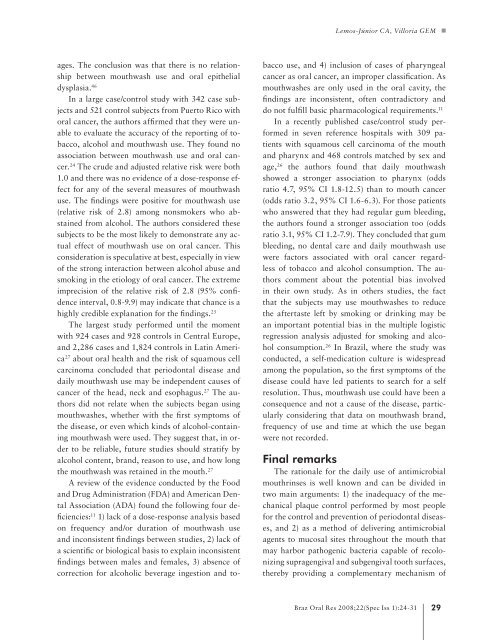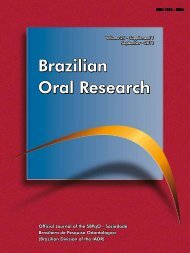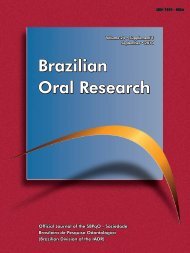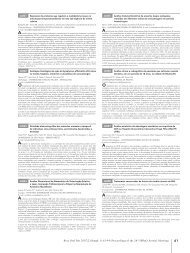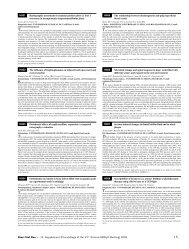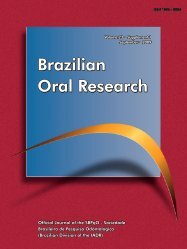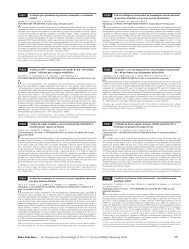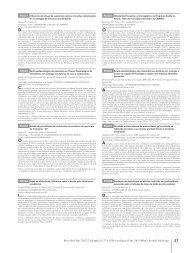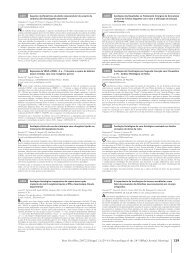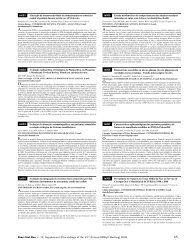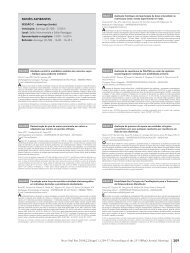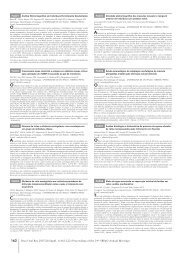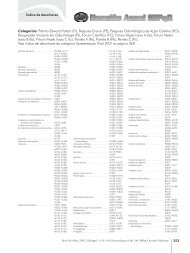Brazilian Oral Research Brazilian Oral Research Brazilian Oral
Brazilian Oral Research Brazilian Oral Research Brazilian Oral
Brazilian Oral Research Brazilian Oral Research Brazilian Oral
You also want an ePaper? Increase the reach of your titles
YUMPU automatically turns print PDFs into web optimized ePapers that Google loves.
ages. The conclusion was that there is no relationship<br />
between mouthwash use and oral epithelial<br />
dysplasia. 46<br />
In a large case/control study with 342 case subjects<br />
and 521 control subjects from Puerto Rico with<br />
oral cancer, the authors affirmed that they were unable<br />
to evaluate the accuracy of the reporting of tobacco,<br />
alcohol and mouthwash use. They found no<br />
association between mouthwash use and oral cancer.<br />
24 The crude and adjusted relative risk were both<br />
1.0 and there was no evidence of a dose-response effect<br />
for any of the several measures of mouthwash<br />
use. The findings were positive for mouthwash use<br />
(relative risk of 2.8) among nonsmokers who abstained<br />
from alcohol. The authors considered these<br />
subjects to be the most likely to demonstrate any actual<br />
effect of mouthwash use on oral cancer. This<br />
consideration is speculative at best, especially in view<br />
of the strong interaction between alcohol abuse and<br />
smoking in the etiology of oral cancer. The extreme<br />
imprecision of the relative risk of 2.8 (95% confidence<br />
interval, 0.8-9.9) may indicate that chance is a<br />
highly credible explanation for the findings. 25<br />
The largest study performed until the moment<br />
with 924 cases and 928 controls in Central Europe,<br />
and 2,286 cases and 1,824 controls in Latin America<br />
27 about oral health and the risk of squamous cell<br />
carcinoma concluded that periodontal disease and<br />
daily mouthwash use may be independent causes of<br />
cancer of the head, neck and esophagus. 27 The authors<br />
did not relate when the subjects began using<br />
mouthwashes, whether with the first symptoms of<br />
the disease, or even which kinds of alcohol-containing<br />
mouthwash were used. They suggest that, in order<br />
to be reliable, future studies should stratify by<br />
alcohol content, brand, reason to use, and how long<br />
the mouthwash was retained in the mouth. 27<br />
A review of the evidence conducted by the Food<br />
and Drug Administration (FDA) and American Dental<br />
Association (ADA) found the following four deficiencies:<br />
11 1) lack of a dose-response analysis based<br />
on frequency and/or duration of mouthwash use<br />
and inconsistent findings between studies, 2) lack of<br />
a scientific or biological basis to explain inconsistent<br />
findings between males and females, 3) absence of<br />
correction for alcoholic beverage ingestion and to-<br />
Lemos-Júnior CA, Villoria GEM<br />
bacco use, and 4) inclusion of cases of pharyngeal<br />
cancer as oral cancer, an improper classification. As<br />
mouthwashes are only used in the oral cavity, the<br />
findings are inconsistent, often contradictory and<br />
do not fulfill basic pharmacological requirements. 11<br />
In a recently published case/control study performed<br />
in seven reference hospitals with 309 patients<br />
with squamous cell carcinoma of the mouth<br />
and pharynx and 468 controls matched by sex and<br />
age, 26 the authors found that daily mouthwash<br />
showed a stronger association to pharynx (odds<br />
ratio 4.7, 95% CI 1.8-12.5) than to mouth cancer<br />
(odds ratio 3.2, 95% CI 1.6-6.3). For those patients<br />
who answered that they had regular gum bleeding,<br />
the authors found a stronger association too (odds<br />
ratio 3.1, 95% CI 1.2-7.9). They concluded that gum<br />
bleeding, no dental care and daily mouthwash use<br />
were factors associated with oral cancer regardless<br />
of tobacco and alcohol consumption. The authors<br />
comment about the potential bias involved<br />
in their own study. As in others studies, the fact<br />
that the subjects may use mouthwashes to reduce<br />
the aftertaste left by smoking or drinking may be<br />
an important potential bias in the multiple logistic<br />
regression analysis adjusted for smoking and alcohol<br />
consumption. 26 In Brazil, where the study was<br />
conducted, a self-medication culture is widespread<br />
among the population, so the first symptoms of the<br />
disease could have led patients to search for a self<br />
resolution. Thus, mouthwash use could have been a<br />
consequence and not a cause of the disease, particularly<br />
considering that data on mouthwash brand,<br />
frequency of use and time at which the use began<br />
were not recorded.<br />
Final remarks<br />
The rationale for the daily use of antimicrobial<br />
mouthrinses is well known and can be divided in<br />
two main arguments: 1) the inadequacy of the mechanical<br />
plaque control performed by most people<br />
for the control and prevention of periodontal diseases,<br />
and 2) as a method of delivering antimicrobial<br />
agents to mucosal sites throughout the mouth that<br />
may harbor pathogenic bacteria capable of recolonizing<br />
supragengival and subgengival tooth surfaces,<br />
thereby providing a complementary mechanism of<br />
Braz <strong>Oral</strong> Res 2008;22(Spec Iss 1):24-31 2


